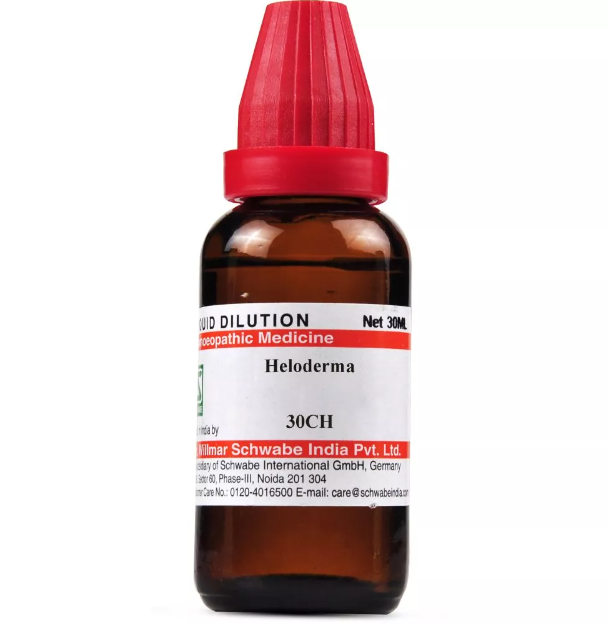HELODERMA 6C, 12C, 30C, 200C, 1M, 10M USES AND SYMPTOMS
 HELODERMA
HELODERMA
(Gila Monster)
Helo.
The bite causes paralysis similar to paralysis agitans or locomotor ataxia, without a tetanic phase—opposite to Hydr-ac. or Stry. The most notable effect is on a mouse’s eye, causing eyeball protrusion and corneal opacity due to blood pressure behind the eye (Boyd). Homeopathically, it treats diseases with extreme coldness. Cold waves move from the occiput to the feet or ascend.
Head: Deep depression. Sensation of tilting to the right. Cold band encircling the head; cold pressure inside the skull. Heavy eyelids. Pain starts in the right ear, circles to the back of the head, and reaches the left ear.
Face: Cold, tingling sensation as if facial muscles are taut.
Mouth: Cold, tender, dry tongue. Very thirsty. Difficulty swallowing. Cold breath.
Chest: Cold sensation in lungs and heart. Slow, effortful thumping of the heart (oppressive heart action).
Back: Coldness across the shoulder blades. Burning sensation along the spine.
Extremities: Numbness and shaking (Parkinson’s-like paralysis). Bluish discoloration of hands. Coldness. Feeling of walking on a sponge, with feet seeming swollen. Unsteady gait. Stiff-legged gait. When walking, raises feet higher than usual and heels hit the ground firmly (unsteady movement). Feet as cold as ice or burning. Stretching eases muscle and limb pain.
Fever: Internal coldness, as if frozen. Cold rings around the body. Cold spells (Abies-c., Acon.). Cold patches. Arctic coldness. Subnormal temperature—96 degrees (Camph.).
Relationship: Compare with Lacerta agilis (Green lizard) for skin eruptions, vesicles under the tongue, heightened mental acuity, difficulty swallowing, excessive saliva, nausea, and intense stomach pressure. Also compare with Camph., Lach.
Dose: Thirtieth potency.
SYMPTOMS OF HELODERMA
Head:
Very depressed feeling.
Sensation of falling to the right side.
Cold band around the head; cold pressure within the skull.
Heavy eyelids.
Pain starting in the right ear, extending around the back of the head to the left ear.
Face:
Cold crawling sensation, as if facial muscles were tight.
Mouth:
Tongue feels cold, tender, and dry.
Very thirsty.
Difficulty swallowing (dysphagia).
Cold breath.
Chest:
Cold feeling in the lungs and heart.
Slow, laborious beating of the heart.
Back:
Coldness across the shoulder blades.
Burning sensation along the spine.
Extremities:
Numbness and trembling (similar to paralysis agitans).
Cyanosis (bluish discoloration) of the hands.
Cold sensation.
Feels like walking on a sponge; feet may feel swollen.
Staggering gait or cock’s gait.
When walking, lifts feet higher than usual, with the heel coming down hard (similar to locomotor ataxia).
Feet feel cold as ice or may have a burning sensation.
Stretching relieves pain in the muscles and limbs.
Fever:
Internal coldness, as if frozen to death.
Cold rings around the body.
Cold waves.
Cold spots.
Arctic coldness.
Subnormal temperature (around 96 degrees Fahrenheit, like Camphor).
selection of the potency
Individualization:
- Homeopathy is based on the principle of treating the individual, not just the disease. The unique symptoms and characteristics of the person are crucial in determining the most suitable potency.
Intensity of Symptoms:
- The intensity of the symptoms guides the choice of potency. If the symptoms are intense and acute, a lower potency (e.g., 6C, 30C) might be considered. For chronic conditions with less intensity, higher potencies (e.g., 200C, 1M) may be appropriate.
Sensitivity of the Patient:
- Some individuals are more sensitive to homeopathic remedies, while others may require higher potencies. The practitioner considers the patient’s sensitivity when selecting the potency.
Acute vs. Chronic Conditions:
- Lower potencies are often used for acute conditions, while higher potencies may be considered for chronic or long-standing issues.
Previous Response to Potencies:
- The patient’s response to previous homeopathic treatments helps guide the choice of potency. If a particular potency has been effective in the past, it may be repeated or adjusted as needed.
Vital Force and Susceptibility:
- Homeopathy views illness as a disturbance in the vital force. The practitioner assesses the patient’s overall vitality and susceptibility to determine the appropriate potency.
Aggravation or Amelioration:
- The direction of the symptom response (aggravation or amelioration) after taking a remedy can influence the choice of potency.
Miasmatic Considerations:
- In classical homeopathy, the concept of miasms (inherited disease tendencies) is considered. The practitioner take this into account when selecting the potency.
Practitioner Experience:
- The experience and preference of the homeopathic practitioner play a role. Some practitioners may have success with certain potencies based on their clinical experience.
SAFETY INFORMATION
- Do not exceed the recommended dose by physician
- Keep out of the reach of children
- Store in a cool dry place away from direct sunlight
- Maintain half an hour gap between food/drink/any other medicines and homoeopathic medicine
- Avoid any strong smell in the mouth while taking medicine e.g. camphor, garlic, onion, coffee, hing
Medicine images use for reference only selection of homeopathic medicine depends on the individual’s specific symptoms and overall constitution. Moreover, homeopathy is a holistic system of medicine that treats the individual as a whole. In addition to addressing the physical symptoms, it takes into account the emotional and mental state of the person. Consequently, it’s crucial to consult with a qualified homeopathic practitioner for personalized treatment.
The information provided on this website is intended solely for educational purposes. Always seek the advice of your physician or other qualified health provider.
